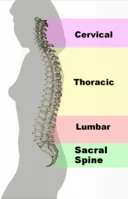Spinal Anatomy
The spine consists of 33 separate bones that are carefully stacked one on top of the other. There are multiple muscles and ligaments that keep the bones in their correct alignment so that the spine can be the main supporting portion of the body. It allows for being able to bend, twist, and stand upright, and it protects the spinal cord from damage by creating a cage around it with various processes in the vertebrae.
Each of the vertebrae is different and they allow for a normal spinal curvature. There is a curve in the neck, a slight kyphosis, or reverse curvature of the thorax and a curve in the lumbar spine. It is the responsibility of the lumbar spine to bear the brunt of the weight of the body. The average vertebra has a cylindrically-shaped body, a posterior spinous process, two lateral transverse processes and two upper and lower processes for articulating the vertebrae to one another.
The vertebrae have a cushion-like structure called an intervertebral disc. It is made from an annulus, which forms a tough fibrous ring around the top of one vertebra and the bottom of the vertebra above it. Inside the annulus is a gelatinous substance called the nucleus. It provides the bulk of the cushioning between the vertebrae.
Unfortunately, there can be too much stress on the disc, resulting in bulging of the annulus or rupture of the annulus, with spillage of the nucleus into the intrathecal space. In such cases, the material can put undue pressure on the spinal nerves that exit the spinal cord or on the spinal cord itself.
The back portion of each cylindrical spinal vertebral body contains several projections as mentioned above. The two supporting pedicles and the two laminae together form the vertebral arch. They form the spinal canal to hold the spinal cord, fatty tissue, blood vessels and ligaments. Beneath each pedicle is a canal through which the spinal nerves exit to the body. Each vertebra also contains a superior facet and an inferior facet, which form the joints that connect each vertebra to the one above and below it. These connections are known as the “facet joints”.

The ligaments of the back are long fibrous bands that connect the vertebrae together. There are three major ligaments in the back. They are the ligamentum flavum, the posterior longitudinal ligament, and the anterior longitudinal ligament. The run the extent of the spinal column and prevent too much movement from occurring in the vertebral bodies. The ALL and PLL run along the vertebral bodies, while the ligamentum flavum connects the lamina of each of the vertebrae.
The spinal discs can cause pain and disability in two ways. It can become disrupted due to a sudden trauma such as a car accident, fall, or sporting injury. In such cases, pain has a sudden onset as the annulus is disrupted and the nucleus herniates out from inside its tough outer shell.
There can be symptoms of disc injury in the cervical area, the thoracic area or the lumbar area of the spine. Common symptoms include:
• Pain in the cervical region
• Pain in the back
• Pain in the arm or arms
• Pain down the leg or legs
• Any combination of the above symptoms
In extreme situations, the patient can have a large herniation of the disc. This can result in weakness in an arm or leg, or signs of compression of the spinal cord, including gait abnormalities, loss of coordination, or difficulties with bladder or bowel control.
Facet Joint Injury
The facet joints are present in the spine in order to prevent over twisting or tipping over of the vertebral bodies. Facet joints provide about twenty percent of the twisting ability of the low back and the cervical spine. These joints are present at all levels of the spine except at the level of the first cervical vertebra. The thoracic area vertebrae do not twist much at all but are permitted a minor amount of flexion and extension and a bit of bending to the side. In the low back, forward and backward motion is allowed to about twelve degrees with lateral bending allowed to about 5 degrees. Rotation of the lumbar spine can occur to about 2 degrees for each segment.
The facet joints normally do slide against each other. Each part of the joint is coated by low friction cartilage that allows for free movement. There are lots of nerve endings around the joint in order to tell us when the joint is inflamed or in danger of being dislocated.
Trauma can disrupt the cartilage and send the joint into a dislocated state. The raw bone without cartilage can form a bone spur around the joint, thus enlarging the joint. This can lead to osteoarthritis of the spine—a situation of chronic back or neck pain. When this happens, it is also called faced joint syndrome or facet joint disease.
When the facet joints are irritated or inflamed, there is a protective reflex which occurs. It causes the nearby muscles to become spasmed. This is especially true when the facet joints become dislocated. The person cannot move the back in any direction until the facet joints are put back in their proper place.
Symptoms of facet joint injury include:
• Sudden episodes of lumbar or cervical pain in the area of the facet joints. These are unpredictable and intermittent episodes that occur every few weeks or months.
• There will be an ongoing point tenderness directly over the location of any inflamed facet joints.
• There will be guarding, which is a relative immobility of the spine due to lack of flexibility of the muscles.
• The pain is worse when leaning backward more than leaning forward.
• If the facet joints impinge on the spinal nerves, there will be pain radiating down the back of the leg to about the level of the knee.
• Cervical facet joint injury will cause radiating pain to the shoulder or down the upper part of the back. Rarely does it go past the elbow.

If you or someone you know has been injured in an auto or motorcycle accident, call me at (916) 921-6400.
Be sure to read our reviews at Yelp! and Avvo.
